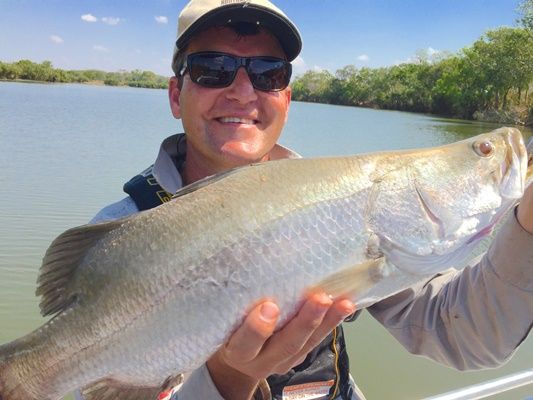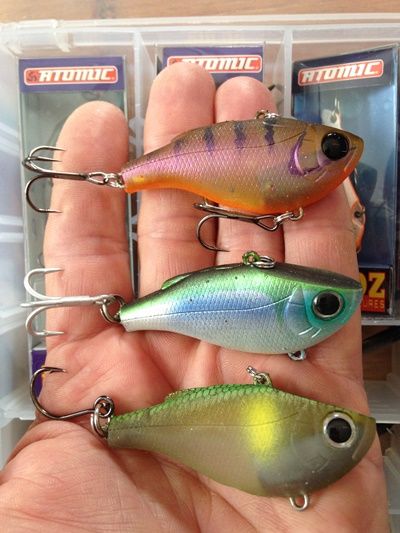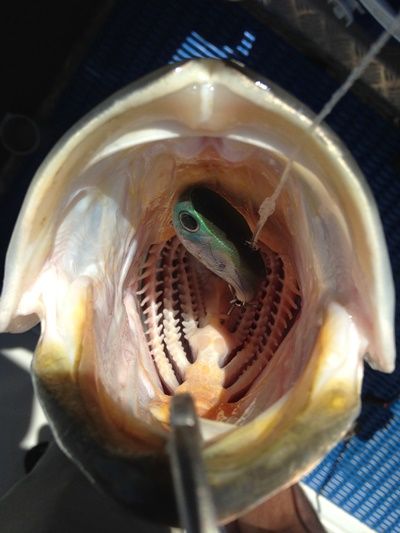Latest News
Fun New Ways to Catch Barra!
Tuesday, 4 August 2015
On a recent trip to the NT I was told that the barra are slow in winter but I hear this every year and was keen to see if could again prove otherwise.
My team and I had introduced things like downsizing tackle, bibbless minnows, softies and finesse hard bodies to the locals and our Fishing Australia TV audience over the past 15 years, and these techniques are now commonly used by many. This time around I had a few extra tricks that would hopefully up the catch rates further.
First up we hit the East Alligator River with local Kakadu guide Shannon Summerton. The strategy was to cover a bit of ground by trolling deep diving barra lures and if we sounded up a school along the way we would drop in some new soft vibe style lures. Hard body vibes had worked well on barra in the past, but the soft vibes I got my hot little hands on were proving to be a revelation on XL flathead, snapper, jew and a huge range of fish down south, so we were all keen to see what the barra thought.
We got a few touches but no hook ups and we were struggling to catch a barra or get our trolling lures to the sounded barra in the 7 meter deep holes on the up current side of the rock bars. So as planned we stopped and cast in the soft vibes, let them sink to the bottom and boom it was game on-we caught a dozen barra in less than an hour before the sun got low and bull sharks moved in and slowed up the bite.
A few pointers for this scenario: the deep holes were rocky but not too snaggy thanks to having little if any timber so 20 or 30 pound main line with 30 pound fluro carbon leader was all we needed; this lighter leader meant more bites. Also our leader was only 70cm or so long so it didn’t have to run through the fine guides of the finesse thread line rods we used (in this case a Storm Mojo S602M which is rated between 8 and 17 pounds)
The soft vibe lures I’ve been putting to the test around the country are known as Atomic ‘Semi Hardz’ and they come in 40, 50 and 60mm sizes weighing roughly 11, 15 and 22 grams respectively. The standard lighter gauge hooks the lures come with have been good on southern mentioned species and they also worked well on the 40 to 65 cm barra because you can coax them up gently with the light tackle. However we found that in some scenarios we removed the middle treble all together and put a stronger treble on the tail of the lure. Given barra have a big mouth and the soft vibes are a smallish lure they were typically inhaled without it getting hindered on the way in (as often happens with large lures). This meant the bite to solid hook-up conversion rate was exceptional.
Selecting the thickness or strength of the trebles we put on the tail is a bit of an art. In snaggy areas, especially timbered spots you can use hooks light enough so that your main line can bend the treble open if you flat line the rod and pull extra hard (much harder than you would ever pull with a bent rod when tackling a barra). This way you get your lure back, bend the treble back into shape with your pliers and get back into the fishing in double quick time (I want you to collect more lures rather than replacing too many of ones you have already brought). However in some instances you simply need a heavier treble to wrestle out bigger barra in snaggier areas and unless you’re using more traditional 50 pound braid and 80b pound leader you won’t be able to bend these trebles off a snag.
Another option is an in line single facing upwards, this is more snag resistant but has possibly slightly less hook ups-although I would like to do more on this front before concluding. But back to trebels and at the end of the day you need to pick hook strength to suit the tackle environment and size of fish you are targeting. On most barra trips I take a the spin stick mentioned above, a sightly lighter version and also the typical heavier 50 pound braid 80 pound leader baitcaster. Then in my soft vibe tray I have a variety of weights/sizes rigged with various strength trebles/singles and pick them to suit the terrain/fish size on location.
The technique was pretty straight forward: cast out towards the spot the barra are holding or have been sounded. Let the lure sink on a tight line because some bites came on the drop, and from there you either hopped it back across the bottom in a flathead like retrieve or even burned it back and everything in between. Slower and close to the bottom retrieves were typically best though. Handy thing is these lures are so versatile that with a little bit of experience you can work them across just a meter of water or the deep holes / vertical snags we most commonly targeted. It was fun to play around with the retrieves, but the best thing of all is that it’s easy to feel the soft vibes working (vibrating), and we found even beginners that joined us got excited and focused when they felt their lure is working like this. One word of caution here, you get what you pay for-the well balanced quality soft vibes we used vibrated well even with larger trebles on. We also tried a few cheap versions and they just didn’t have the vibe that got us and the barra excited.
We used the same approach and techniques with Shannon in a couple of Billabongs and tributaries ie we would find a few fish on the troll and then cast at them or where is was very deep/snaggy/strong current jig straight up and down. In some cases we went from hoping to catch half a dozen barra to catching 30 an hour and leaving them bitting. Shannon and others we worked with were just as hooked on the soft vibes as we were!
About the only speed bump we hit was when a South Easter set in, which ‘can’ make barra fishing up north tough in winter, but even then it was the soft vibes that pulled the barra. In this case we were fishing the mangrove lines tidal creeks at La Belle Station from the bank and the soft vibes were handy in getting down to the middle of the channel where the barra were holding. The across and down technique worked best in this scenario. Just hop the lure along the bottom and sound out the 5 to 6 meter deep holes with the countdown technique and presto, we would find fish. This was infinitely more practical than diving lures in this scenario.
A little bit of testing showed that hard bodies vibes, especially those with rattles, also worked, especially in murkier/faster water but often the fish wised up quickly to their noise. Various softies also worked, as did the metal vibes (Atomic Hardz in this case), but the soft vibes worked best in the scenarios we fished on this trip.
I’m certainly not the first to use soft vibes on barra, and of course every type lure has a place where it suits and works best and I carry a large variety for this reason. But from this trip and the feedback flowing in from guides ever since I think you’ll be seeing more soft vibes in barra fishing kits in years to come, they are a very handy tool indeed!
If you would like more detail on knots, tackle, locations and techniques there is full on dedicated instructional chapters on Barramundi in my books and dvd’s available at www.robpax.com or www.fishingaustralia.tv
See you on the water.
Rob Paxevanos





